Video on Demand (VoD)
© Mercury Communications Ltd. - Mar. 1994
![]() 2007
network writings:
2007
network writings:
![]() My
TechnologyInside blog
My
TechnologyInside blog
Television broadcast, satellite, and video rental represent major markets in the UK and the many hours of broadcast video that are welcomed into most UK homes are a powerful influence on lifestyle and purchasing decisions. These multi million pound markets have so far been dominated by network TV companies, cable and satellite operators, but, will this still be the case at the end of the decade?
Over the last six months newspapers and magazines have published an unprecedented number of column inches dedicated to digital superhighways and video on demand. Even the Sunday Times has had at least three long articles, the last one being entitled "Can BT become a media giant?" . Akin to other areas of new technology, the race is being set in the USA with many of the regional Bell operating companies (RBOCS) having made public declarations in the last few months. It is clear that some are more bullish than others. Indeed, partisan propaganda flows like never before. Take the Sunday Times article for example. Jones Cable: "A low quality, unreliable service offered ten years too late." Encom: "My technical people say it will be prohibitively expensive and geographically limited.".
The Sunday Time article starts with the paragraph "Does the technology really exist to pump video pictures down a telephone line? Is BT serious about operating a video-on-demand service?" This issue of Technology Watch looks at Video on Demand and attempts to answer some of these questions .
What is Video on Demand (VoD)?
Simply put, Video on Demand is television that is under the control of the viewer.
It promises to let users watch programs when they want to rather than when the broadcaster decides to broadcast them; in fact, a super VCR.
It promises to allow viewers to watch videos with full VCR control without having to go down to the local rental shop. It is possible that eventually you will be able to dial up any film ever made.
More importantly however, it will allow access to a plethora of interactive video services, such as home shopping, home education, libraries, CD libraries, or help desks.
It is commonly claimed that Video on Demand standards and equipment including the video server, network, and set-top boxes will provide the underpinning architecture that will allow most of the newer information based services such as home shopping to be delivered economically to the home. It will not be possible for any public tele-communications operator (PTO) to ignore VOD and believe they have a coherent strategy to deliver advanced services to the home.
So What has Changed?
Many technological advances have combined to create the environment for Video on Demand.
Digital electronics has brought digital compression in the form of MPEG down to a single chip and well within the costs needed by consumer products.
- Asynchronous digital subscriber loop (ADSL) has enabled the delivery of a single 2 Mbit/s MPEG encoded video channel over a standard twisted pair copper local loop.
- PCs have brought down the cost of computing power significantly to enable it to be built into set-top boxes economically.
- Graphical user interfaces (GUI) have advanced sufficiently to enable variants to be built into consumer products e.g. Microsoft at Work.
- Major breakthroughs in video server technology promises the capability to support tens of thousands of customers from a single server.
- Intelligent network (IN) and Synchronous Digital Hierarchy (SDH) capabilities in public operators provide the underlying capabilities of running and managing broadband services.
- Consumers are prepared to pay for new technology: sales of PC multimedia CD-ROMs, cable TV, HI-FI, and Sega games provide evidence of this.
- Major corporations in the computer, content, network and original equipment manufacturers (OEMs) are committing to upgrade plant and equipment to handle new video services.
Figure 3 shows only a subset of key industry players who have made public announcements in the last twelve months. Can this all be put down to a frenzy or mass hysteria?
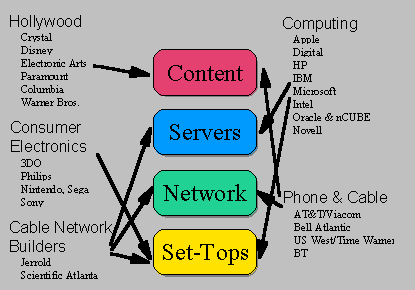
The Two Types of Video on Demand
Video on Demand can come in several flavours ranging from simple to complex from an architecture point of view.
Simple VoD
Some cable companies or hotels currently provide a modicum of user control. These work by using existing analogue techniques for delivering programming but provide a reverse control path by various means. This include using a spare channel of a cable TV tree-and-branch coax system to aggregate data supplied by the user, using a standard terrestrial telephone line, or using a dedicated radio link (as seen in the USA). All these systems take a pragmatic approach to the challenge of VOD and provide only limited capability.
Full VoD
Full Video on Demand capability utilises a digital solution as shown in figures 3 and 4. This aims to provide customers with a range of completely new services. It is hoped that viewers can be provided with complete control allowing them to request the news or films at any time of day - instantly. The system will also enable home shopping, participation in network games, or undergo re-education from a network based university. Full Video on Demand is expensive and some time away. However, many companies are launching trials in 1994, Bell Atlantic and British Telecom to name but two.
An Video on Demand Architecture
The architecture of an Video on Demand system is highly dependent on the nature of delivery to the home. A cable company will utilise its coaxial tree and branch system. For example, Pacific Telesys is investing in a fibre back-boned network with coax feeding individual homes in groups of 500. In this case there is plenty of bandwidth to provide both backward compatible analogue services (so old analogue set-top boxes can still be used) and the delivery of digital telephony, data, and video services. On the other hand, Bell Atlantic and British Telecom are running a trial based on ADSL which allows the delivery of a single digital MPEG-encoded video stream to the home whilst still allowing telephone calls to take place at the same time as watching a film. Figures 3 and 4 show the architecture of an ADSL based system as being used by BT.
The Exchange End
Figure 3 shows the exchange end of a VOD system. The master server would be located centrally in the network because it would need to house a massive and highly resilient database. The master server would not itself be directly connected to the user but would act as a central repository for storing films and other material. When it is remembered that storing a single MPEG encoded film would take up 1.5 Gbytes of disk space it should be realised that this computer would need to have a vast amount of disk space if it is store hundreds of films. Indeed, a 'new' term is required, terabytes (1 Tbyte = 1000 Gbytes)!
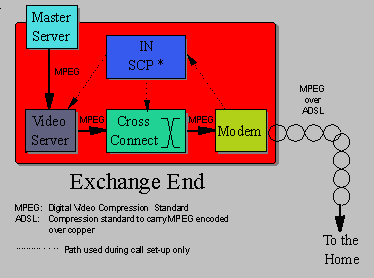
Figure 3 - The Exchange End of a VOD System
One of the key components to a VOD system is the local video server. The technical challenge here is not so much that the server has to store a vast number of individual films but rather how can such a device be capable of delivering individually controlled video streams to tens of thousands of customers at the same time? 1993 produced several solutions to this challenge. Although there are others, the solution provided by Oracle and nCube will discussed in detail later.
The video server is connected via 2 Mbit/s (E1) SDH cross-connects to the individual customer ADSL modem. This in turn is connected to the customer's copper local loop.
Making a Video Connection
When a customer wishes to watch a film, or see the news that started ten minutes ago, or start a home shopping spending spree, they dial a special number on the local exchange. This connects them to an interactive voice response (IVR) system that welcomes them to the service and asks for the user's service pin code. At this stage just an ordinary telephone call is taking place. Once the customer's code has been verified using the intelligent network's (IN) service control point's (SCP) database, the SCP sets up a permanent 2 Mbit/s video connection between one port of the local video server and the ADSL modem connected to the customer's local copper loop. Once this connection is made, the server transmits the service's logo or brand screen over the copper to the customer's TV. Following this, the customer can preview films or make their selection of which service to use.
In The Home
Figure 5 shows the equipment that is located in the home, the most important of which is the set top box (STB).
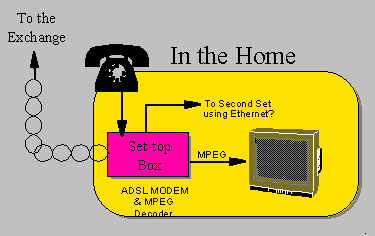
Figure 5 - VOD in the Home.
In its simplest form the set top box has three main constituent components: the ADSL modem, MPEG decoder, and a graphical interface. The ADSL data stream arriving from the exchange (which uses a real bandwidth of around 250 KHz) is demodulated into a 2 Mbit/s MPEG data stream by the ADSL modem. The MPEG decoder then converts the 2 Mbit/s data back into analogue video which is delivered to the domestic TV via a standard SCART socket. Alternatively, a personal computer could be used to display the video. In this case conversion to an analogue signal is not required.
Enabling Technologies
The possibility of Video on Demand has been brought about by innovative technological advances in several fields, these include, digital video encoding, video compression, video servers, and video switching. Each of these areas has attracted key players as shown in Figure 3. In recent months, Oracle and nCube have been making headlines in the domain of video servers, especially since they announced $20M agreements with Bell Atlantic and BT.
Video Servers
Video on Demand services that deliver real-time video require the use of a video server. The video server is 'nothing more' than a large database with some very special characteristics. Most computer manufacturers including Digital, IBM, and HP have been demonstrating video servers for a number of months and software companies such as Microsoft have recently been making public pronouncements.
The key technical challenge for a video server that is to be used to support a public video on demand service is the question of scaleability. Such a service requires a server architecture that can deliver different 2 Mbit/s data streams to tens of thousands of customers at the same time. This has been beyond the capability of most traditional computer manufacturers although early trials have been based on the use of IBM 6000 platforms. There now seems to be two alternative solutions to this key challenge. One comes from a partnership between Oracle and nCube based on a combination of nCUBE's massively parallel processor (MPP) and Oracle's database. This is a centralised, big server, solution. Another approach is to use distributed PCs based on a fast network. Not surprisingly, this approach is being proposed by Microsoft.
The Oracle and nCube Server
Oracle Corp: Is a well known US company whose competence and expertise lies in the domain of enterprise-wide, multi-platform (PC, UNIX, mini & mainframe), client-server database applications.
nCube: is a company who manufacture a specialist computer family based on massively parallel processing (MPP) computing principals. These computers have found application where a task can be split up into processes that can be computed in parallel. This results in awesome compute capability which is ideal for such applications as weather modelling, computer aided design (CAD), and surface rendering. The founder of Oracle, Larry Ellison, bought nCube lock, stock, and barrel several years ago. In the area of video servers nCube and Oracle are working closely together although Oracle are clearly stating that their technology will be open and will work on other MPP based machines as well (although there are not that many!).
A typical MPEG encoded compressed video requires upwards of 1.5 Gbyte (1500 Mbytes) of hard disk storage, therefore a VOD service supporting hundreds of films requires thousands of gigabytes of storage. Moreover, Video on Demand can fully replace conventional broadcast to provide programs on demand thus increasing overall storage requirements dramatically.
The concept of Video on Demand requires that an individual gets what they want when they want it, therefore a video server needs to be able to provide tens of thousands of customers with individually controlled video streams. For VoD, this means that all parts of a single video stored on a hard disk would need to be accessed at the same time as many individual customers could be looking at a different part of the film. This is impossible to achieve with conventional computer technology. Oracle and nCube claim to have a solution to this problem that seems to make sense without pushing technology to the edge. How do they do it? Not surprisingly the server technology is based on a combination of the use of MPP computers and RAID disk technology.
MPP Technology
Massively parallel computing is a simple concept to understand (see Figure 6).
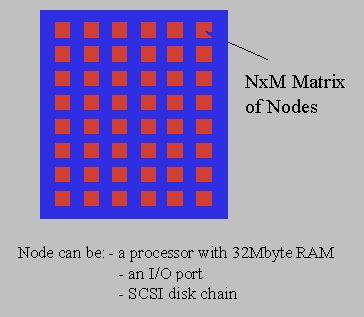
Figure 6 - The Basic nCube Architecture.
An MPP computer consists of an array of individual computing elements that are interconnected. These nodes talk to each other either directly or indirectly via another node and pass messages and data to each other. A node can be a data processor, an input/output port, or a SCSI disk chain. A processor node consists of a custom designed RISK engine with either 32 or 64 Mbyte of RAM. It is possible to load a complete copy of an Oracle database onto each node thus creating an Oracle database server of unprecedented power. According to nCube, in this application, nCube outperforms all computers, including CRAY!
RAID Technology:
Oracle's video server is based on the use of RAID rotating disk technology. RAID is an acronym for redundant array [of] inexpensive disks. Rather than using a single and very expensive multiple platter disk, RAID based systems uses an array of low-cost SCSI disks as used on PCs. With RAID level-2, it is now possible to mirror data on a number of disks. Mirroring means that there are duplicate copies of files on different disks, thus if a disk fails it can be physically replaced (while the machine is still on) and the second copy of the data copied back onto the new disk automatically by the operating system.
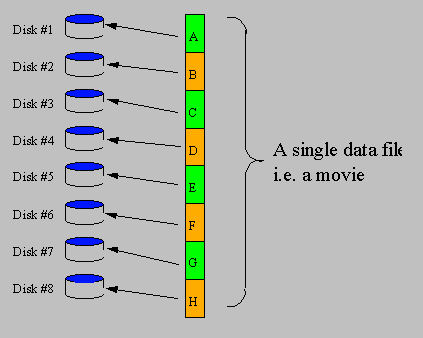
Figure 7 - RAID Disk Striping.
Also, a single file can be striped across many disks i.e. sections of a single data file are stored on many disks as shown in Figure 7. To access a single contiguous file, all disks on which the file is saved are accessed sequentially and the file is reconstructed block by block. Thus, if there are 'N' disks, read/write head movements are reduced by a factor of 'N'. Thus it is possible to support many separate accesses to a single file at the same time without being limited by the time the disk head needs to move from sector to sector. This is what is needed for a VoD server to provide access to a stored film file to thousands of customers at the same time each looking at a different part of the film.
nCube Video Server Architecture
In the Oracle video server, an individual processor node is allocated to a video stream (a customer). An individual node can support up to around ten MPEG data streams (see figure 8). It is possible to support up to 2,000 combinations of processor nodes and SCSI disk chains.
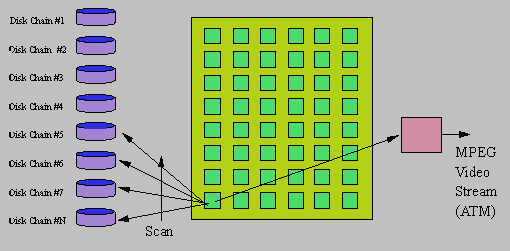
Figure 8- Oracle Video Server Architecture
When requested by the network's IN SCP to deliver a film to a customer, a particular node is allocated to the task. The node processor then sequentially scans the RAID disks which stores the particular film required and assembles the individual data blocks into a continuous MPEG encoded video stream and places it on a nominated output port. This can be a T1 or E1 or possibly ATM encoded port. The video stream is then routed to a traditional PDH 2 Mbit/s cross-connect, SDH cross-connect, or ATM switch for delivery to the customer. Oracle claim to be able to support up to 7,000 totally independent MPEG data streams with this configuration!
Alternative Video Server Architectures
Several companies, including Microsoft, have announced video servers based on distributed PCs connected to a high speed LAN. Although not much is known in the public domain about what Microsoft are up to, a company called Starnet has been more open. This system is based on a Windows for Workgroups peer-to-peer LAN configured with 35 Gbytes of disk storage. This provides a capability for storing thirty five films. Although this type of network is clearly capable of fulfilling a role as an enterprise video server, it far from clear whether it would ever be capable of supporting a public Video on Demand service.
SET-TOP BOXES
The set-top box is a crucial component to the concept of delivering video and information content to the home for the following two reasons:
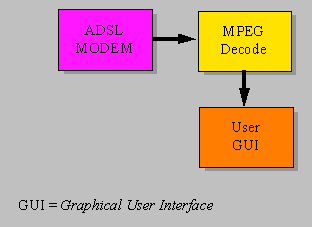
Figure 9 - Set Top Box Components
Standards
There is little room for multiple set-top boxes in the home and a standard has not yet formed. Many companies who are currently in that market (or not!) are busy developing boxes that they hope will become the standard. These are usually consortiums consisting of a semiconductor vendor, a software vendor, and a hardware manufacturer. One well known one is General Instrument, Intel, and Microsoft.
Low Cost
Video on Demand is ostensibly a consumer product, therefore the cost of a set-top box needs to be low. This is principally driven by the ability of semiconductor vendors to integrate all the required functionality into a single chip that can be manufactured in high volumes and at low cost. This is not yet possible in this domain as a set-top box has two major components that are very complex in their own right: ADSL and MPEG. A single chip MPEG decoder is only just available and no one has yet has yet announced a single chip ADSL decoder. Both of these devices will initially cost in excess of $100 making the cost of set top boxes very high. One company, Motorola, is stating that its own single chip ADSL chip will not be available until 1996. For BT's trial, they will use ADSL equipment based on Motorola chips and Apple hardware.
For more advanced services however the set top box is more than a dumb unscramber, yet the cost has to be beaten down to less than say £200. A typical box might contain a powerful CPU, such as a 486, 1 to 3 Mbytes of RAM, a high speed graphics chip, a 1 GHz tuner, a demodulator, a decrypter, a Dolby sound decoder, an infra-red controller, flash memory for storing the operating system, and a switching power supply. If all this costs greater than £1000 who is going to buy it?
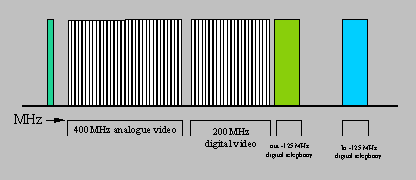
Figure 10 - Coaxial Telecommunications Standard
The Local Loop
Although ADSL is being used by Bell Atlantic and BT in their Video on Demand trials, it is unlikely that this technology will be being used in ten years time. ADSL is only interesting because uses existing copper local loop. Other public operators are taking an alternative approach by committing to deploy coaxial cable into all homes e.g. Pacific Telesys. For Video on Demand this has the benefit of maintaining compatibility with existing cable TV analogue set top boxes while enabling customers to upgrade to digital services when they so wish. This ability is based on extending the bandwidth of current analogue coax standards used by cable companies as shown in Figure 10 below.
This standard includes backwards compatibility to support 60 channels of 6 MHz per channel analogue video; 260 channels of digital video at 3 Mbit/s and 4 bits per Hz; and two 75 MHz channels for digital incoming and outgoing telephony. The standard also supports a pair of 50 MHz channels for PCN services. It is clear that the deployment of this type of local loop will bring cable and telephone companies head to head.
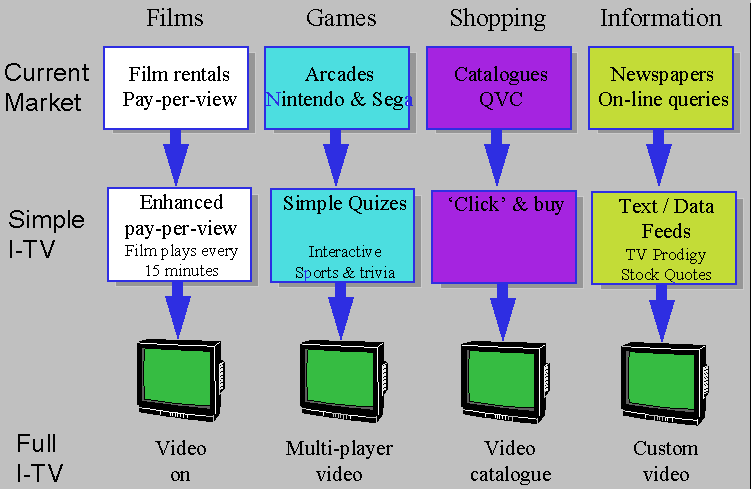
Figure 11 - Video on Demand's Prime Applications. (Source: Forrester)
Video on Demand Services
Figure 11 shows the prime applications for Video on Demand; films-on-demand, games, shopping, and information delivery. These are split between simple and full Video on Demand examples.
Application Value Proposition Home Shopping Quick,targeted search
Wide range of product information
Save time
Information Ability to search for information
Games Try before buy
Interactivity with other players
Instant availability
Transactions Save time
Visual confirmation
Additional information
Education Better effects to aid learning
Learn at home
Access to infrequently used information
Video-on-demand Time saving
No out on rental
Review before purchase
What Will Hold Full Video on Demand Back?
Can it be affordable?
TVs, satellite systems, and simple set top boxes for use by cable TV companies are cheap. Full Video on Demand set top boxes are likely to be very expensive initially. In effect they are PCs with 1 to 3 Mbyte of memory and large hard disks with the addition of ADSL and MPEG decoders. The consensus is that set top box sales will need to be subsidised initially. According to Forrester, and other market research companies, this could derive from advertising sales. Also, the cost of the set top boxes will be highly dependent on how much intelligence will be placed in the network. Further, the cost of the infrastructure for the delivery of Video on Demand looks initially to be very high, especially the video server.
Cost of video delivery v. cost of telephone calls
It has already come to the attention of the media that the cost of a film delivered over your local loop should cost little more than renting a video i.e. £2 to £3. Using the same infrastructure for a 90 minute telephone call would cost considerably more. This raises interesting service and marketing issues!
Will the technology work?
There are major questions with regard to the use of ADSL. 'Experts' seem split between total love or hate. It is also fair to ask questions about the ability of copper laid down seventy years ago to carry ADSL. This will only be resolved through trials.
Local loop standards
Some operators will deploy services using ADSL, BT and Bell Atlantic to name but two. Others have, or will opt, for putting coaxial cable into homes. Others still may go for fibre. One thing is for certain there will be no common approach. For companies without a local loop, delivery of any full Video on Demand service will remain problematical. It should also be remembered that for cable companies to be able to deliver Video on Demand major upgrades to their networks are required.
Set Top Box standards.
Much work needs to go into set top box, network, and network signalling standards. Many companies are working on these, but there is only room for one set in the market. Who and which one will win out?
Conclusions
Is Video on Demand the next consumer revolution to sweep the western world? Will it transform the telephone, video, satellite, and cable markets? Will we all be able to dial up through our shopping mall user interface for all the video and information services we ever wanted?
Time will tell!
